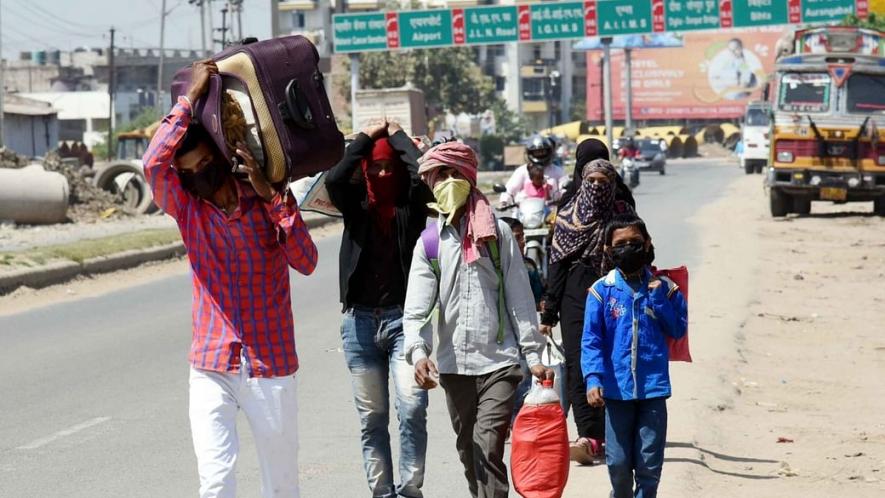Notes from a Field Survey: Perils of Making Class Disappear

Image for representational use only.Image Courtesy : National Herald
The Covid-19 pandemic has highlighted one issue with much clarity, which is that class hierarchies matter. This is most evident in India, where the lower classes have been disproportionately affected by the pandemic. The most glaring example of this is the hardships the migrant workers are facing, though they are certainly not the only group to suffer. Despite this, there is less focus in the mainstream media on class based disadvantages, particularly on how these disadvantages are formed and reproduced in society.
Instead, the discourse on class, even within academia, often underscores its waning importance. The American sociologist Vivek Chibber makes a strong case for this in his 2011 paper, ‘On the Decline of Class Analysis in South Asian Studies’. He argues that class analysis did not make a substantial dent among Indian intellectuals in the first place, but its decline has accelerated in the past few decades. Indian intellectuals, in his opinion, are more prepared to embrace post-structuralist and post-modernist theories.
Be that as it may, the academics who still work on class in India assert that it has a significant role in creating and maintaining social inequalities. One such field is social mobility studies, whose scholars have shown that even in sectors where selection is based on meritocratic criteria, exclusion based on class location is widely prevalent. Further, the relative mobility of people with fathers engaged in manual employment—the sons and daughters of labourers, for instance—into professional occupations such as doctors, lawyers, professors and managerial staff—remains low. This, the scholars say, indicates the low equality of opportunity in India. In addition, India is a socially stable society, which means that those who are born into a particular social class have a strong chance of remaining in that class. This is just one example of research on class; but it is enough to demonstrate that the trap of social reproduction of disadvantages exists, that class-based disadvantages are durable and are often passed over generations.
Understanding class:
Class can be understood through various intellectual traditions. In this article, I concentrate on how class-based disadvantages are formed and socially reproduced in urban contexts, where the role of education and credentials in getting access to coveted jobs is extremely important. The two main class groups of interest here are those who attempt to rely primarily on education to derive socio-economic benefits. These are the middle classes and all those who fall below them.
It is in fact a salient feature of the middle classes that they have historically relied primarily on education to draw their occupational advantages and, as a consequence, their socio-economic status and prestige. With the relative democratisation of education, this section has increased its investment in education in order to retain their advantage.
Economic liberalisation has made more pervasive the common sense perception that educational credentials will ensure upward mobility of lower classes. Further, in this period, the middle class increased in size and became ubiquitous, as seen in movies or on television and depicted by the advertising industry. In other words, in urban India there is a discernable aspiration for upward mobility into the middle class, and the route is seen to be paved with education.
Findings from a field study in Delhi:
During 2016-17, I collected data for my MPhil in a Muslim-dominated neighbourhood of Delhi, with the primary aim to ascertain the educational disadvantages of males from lower-class backgrounds, mostly those men whose fathers were engaged in manual professions or petty self-employment. The second goal was to look at their employment choices. My detailed interviews were with 11 male youth aged between 18 and 25, and the emphasis was strongly on family background and class location.
The interviewees reported facing multiple forms of disadvantages that translated into lower educational attainment. The first was limited economic resources, which placed immense pressure on them to financially support their families. In the event that they did not perform well academically, this pressure was more palpable. Prolonging school education and bearing the opportunity costs of schooling was simply not affordable for these young men.
The second issue was that they lacked cultural resources which created impediments in their educational careers. For instance they had non-literate parents, poor knowledge of English, lack of support with studies at home, lack of knowledge about which subjects or stream to choose at the higher secondary stage, how to strategise in the event of academic difficulties, and so on. Further, the friendship and peer groups of these men were from similar class backgrounds, all facing the same hardships, which lowered their educational aspirations collectively and finally resulted in their decision to drop out of school.
Despite these primary factors contributing to their dropping out, a majority of these men attributed their incomplete schooling to their own inability to work hard. So pervasive was this narrative among them that it underplayed the role of other factors that contributed to their not being able to finish school.
The narrative of hard work has become a dominant narrative in the context of neo-liberalism. This is because, the state has rolled back from all areas of social welfare, leaving the onus of upward social mobility on the individual. Socio-economic inequalities are being disregarded and everyone is placed on a “level” field. The refrain of hard working individuals and perseverance has become important in this context because that is how the hope and dream of mobility stays alive.
Further, the employment aspirations of these men was limited to petty self-employment; much like what their fathers were doing. Ultimately, the strategies of these men were limited to preventing further downward mobility into the class of the poor. It was all too obvious that education was unable to offer these men an easy route towards upward mobility.
It is worth noting that before these men dropped out of school, they and their parents wanted to secure professional jobs. Many parents wanted their sons to become engineers for instance, and saw education as a means to achieve that. To sum up, lower classes have high aspirations for upward mobility to begin with, but as their structural constraints place impediments along their path, they more often than not fail to realise their aspirations.
Now contrast their experience with middle class Muslim youth, both men and women, aged between 21-34 years, who live in various neighbourhoods of Delhi, and whom I interviewed for my PhD. Their experiences were diametrically opposite those of the men from low-income families. Depending on their parental incomes and resources, these youth attended medium-rung to elite private schools. They had access to cultural capital and took for granted that they would get a college education. Their parents had enough resources that allowed them to prolong their years of education, after which they moved into comfortable employment. Most of them admitted that they are now in the upper middle class, and were no longer in the middle or lower middle class, as when they were growing up.
These two strikingly different examples show how much easier it still is for members of the middle classes to use education to gain upward mobility or at least maintain their class position. The same cannot be said of people below them in the class hierarchy. My study is not unique in that sense; much of my analysis has been noted by other researchers too, both in India and the West. All this work is clear evidence of social reproduction theories in action in society.
There is no doubt that class is a salient feature in the reproduction of disadvantages, especially when we look at the opposite ends of the hierarchy constituted by the middle class and the lower class. At least among Muslims in Delhi, gender and caste are not as important factors when it comes to limiting mobility.
How are social classes formed and maintained?
Social reproduction theorists, notably Pierre Bourdieu, have highlighted that classes are mainly demarcated through their possession of certain kinds of resources. Those with relatively high economic, cultural, and social resources (or capital) are placed above those with relatively low capital. Economic resources can be placed hierarchically simply on the bases of the volume of income, wealth or other possessions, but even cultural resources are ranked. The language skills, expressions, tastes, preferences, knowledge of the lower classes are arbitrarily assigned a low value compared with the cultural values of the upper classes. This is one of the main hurdles in the educational attainment of lower classes and ultimately affects their employment prospects.
This is why the upper and middle classes not only dominate (and practice exclusion) in the economic sphere, but also in the cultural and symbolic sphere. These features of class were evident in the examples which were given from the field-based study and help contextualize class and social reproduction.
Resistance and change:
While class-based disadvantaged are durable, this does not mean change is impossible. Theories of social reproduction highlight how people constantly contest class boundaries and therefore these barriers are always being redrawn. For example, a young school dropout I met, whose father was a labourer and brothers were vegetable vendors, was able to fight against all odds to complete a master’s degree from a well-known university in Delhi. This youngster now aspires for a doctoral degree and wants to become a professor. However, he also worked full-time jobs during his school and college years, and therefore got only a couple of hours to rest every day. Besides, he was in the right place at the right time, for an NGO had helped him access a bridge course which ultimately got him admission into a government school in Delhi.
To endure such hardships and to be forced to rely on chance to show a way out is not a story of victory that society should take pride in. This young man’s story in fact demonstrates collective failure. A majority of children in India are pitted against such extreme circumstances and undergo great agony even for basic aspirations. This is why disadvantages are routinely reproduced in India and children of lower class parents have a high chance of remaining in that class group.
Academics have documented a waning interest in social class in favour of more identity-based frameworks to analyse society, but the exceptional circumstances produced by the pandemic have highlighted the critical need to revisit class. Class was simply abandoned, but it was never absent.
The author is a doctoral candidate at the Centre for the Study of Social Systems, Jawaharlal Nehru University. The views are personal.
Get the latest reports & analysis with people's perspective on Protests, movements & deep analytical videos, discussions of the current affairs in your Telegram app. Subscribe to NewsClick's Telegram channel & get Real-Time updates on stories, as they get published on our website.























